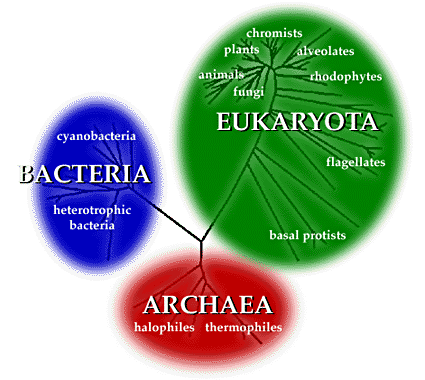classification of life

The three-domain system for the classification of living things.
Living things are placed in groups on the basis of similarities and differences at the organismic, cellular, and molecular levels. Taxonomic studies have led to the development of a system of classification in which all terrestrial life-forms (with the exception of viruses) are divided into several kingdoms. These are further divided into phyla, classes, orders, families, genera, and species.
One of the most contentious issues is the classification of the kingdoms. Originally, there were just two of these: animals (Animalia) and vegetables (Plantae). Gradually, as new discoveries revealed the diversity of life, more were added until the five-kingdom system (including Monera, Protista, Fungi, Plantae, and Animalia) proposed in 1959 by the American biologist Robert H. Whittaker won the support of most authorities. Even this, however, has now been superseded. Research concerning the organisms previously known as archaebacteria has led to the recognition that these creatures form an entirely distinct group. In the six-kingdom system, archeans comprise their own kingdom on a par with those of bacteria, protists, fungi, plants, animals. Coexisting with this is a scheme put forward by Carl Woese in which all terrestrial life is divided into three domains – Archaea, Bacteria, and Eukarya – each containing two or more kingdoms.1
Class
A class is one of the taxonomic groups into which a phylum is divided, ranking next above an order. Class names are printed in Roman (ordinary) letters, with an initial capital;
Domain
Domain is a relatively new taxonomic group above the level of kingdom, first proposed by Carl Woese and his colleagues in 1990. In Woese's scheme, terrestrial life-forms fall into three domains: Archaea, Bacteria, and Eukaryota.
Family
A family is part of the classification of living organisms. It is a group of similar genera of taxonomic rank below order and above genus. Family names are printed in Roman (ordinary) letters with an initial capital; for example, Felidae is the family of all cats.
Genus
Genus is a taxonomic category ranking below family and above species. A genus is a group of closely related biological species with common characteristics; for example the genus Canis includes the dog, wolf, and jackal. Genus names are printed in italic with a capital letter; for example, modern humans belong to the genus Homo. Plural: genera.
Kingdom
Kingdom is the chief taxonomic category. The older, five-kingdom classification scheme include Animalia (animal), Plantae (plant), Fungi, Prokaryotae, and Protoctista. This now been largely superseded by one of six kingdoms.
Order
In biology, order is a taxonomic rank below class and above family. Order names are printed in Roman (ordinary) letters, and begin with a capital letter. Among animals, the names of most orders end in -a, such as Anura (frogs and toads) and Chiroptera (bats), although bird orders end in -iformes, such as Columbiformes (pigeons) and Stringiformes (owls). In plants, order names generally end in -ales, such as Rosales (roses).
Phylum
A phylum is a category in the hierarchy of animal classification ranking above class and below kingdom. Plural: phyla. Phylum names are written in Roman (ordinary) letters and begin with an initial capital letter; for example all animals with backbones (vertebrates) are members of the phylum Chordata. Some phyla are further subdivided into subphyla (subphylum). In plant classification, the analogous category is sometimes called division.
Species
Species is part of the classification of living organisms. A species is a group of individuals that (1) actually or potentially interbreed with each other but not with other such groups, (2) show continuous morphological variations within the group but which is distinct from other such groups. Taxonomically, species are grouped into genera and divided into subspecies and varieties. Each species has a unique two-part Latin name, the first part being the genus name. For example, the tiger's species name is Panthera tigris, Panthera being the genus of the big cats. So far, more than 1.5 million plant and animal species have been identified, but estimates of the total number on land and in the ocean run as high as 100 million.
The modern conception of species as such began with John Ray (1627–1705) in the seventeenth, and was established fully by Carl Linnaeus (1707–1778) in the following century. It was the Linnaean classification system that really emphasized the relationship between similar species, the variations on a theme that so impressed Darwin in his observations.
Superphylum
Superphylum is a taxonomic category lying between a kingdom and a phylum.
Reference
1. Woese, C. R., Kandler, O., and Wheelis, M. L. "Towards a Natural System of Organisms: Proposal for the Domains Archaea, Bacteria, and Eucarya," Proceedings of the National Academy of Science, 87, 4576 (1990).


